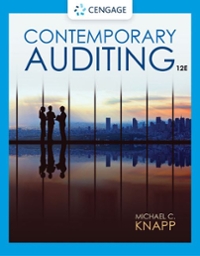Question
Howard Foster has owned and operated his own professional income tax preparation and bookkeeping business as a sole proprietorship for many years. The business is
Howard Foster has owned and operated his own professional income tax preparation and bookkeeping business as a sole proprietorship for many years. The business is quite successful and has gradually grown to the point where Howard employs over 40 individuals full-time, which doubles with the addition of part-time staf to help at tax time. The business offices are located in a building in downtown Halifax that Howard purchased a few months before he began the business.
Recently, a relatively new client threatened legal action against Howard on learning that the bookkeeping services provided had not produced accurate and current books and records, resulting in a reassessment as a result of a CRA audit of the client. Howard personally worked with the client to resolve the issue but was sufficiently worried about the impact of a lawsuit so he decided to speak with his lawyer. The lawyer advised that the land and building be separated from the business to remove it from the reach of creditors should a lawsuit ever materialize. Howard agreed with the advice and a new corporation, 123789 Ltd., was incorporated in Nova Scotia. Howard will be the only shareholder and has acquired 100 common shares for $100.
Howard purchased the land and building for $4,100,000 using $775,000 of his own personal funds and financed the remainder with a mortgage of $3,325,000. Five years ago Howard spent $500,000 on major renovations to add a dozen new offices, which he financed by renegotiating the existing mortgage. The original cost of the property of $4,100,000 was split between the land, which was valued at $680,000, and the building at $3,420,000.
Howard will sell the land and building to the new company on December 9, 2021, for a total of $7,615,000, which represents the FMV of the property according to a recent valuation. The company will assume the mortgage balance. Once the property is sold, Howard and the company will enter into a rental agreement for the continued use of the property in Howard's business. Howard plans to file an election under ITA 85(1) with respect to the sale. Since Howard has realized allowable capital losses of $52,000 in 2021, he wishes to create sufficient taxable capital gains as part of the ITA 85(1) election to offset those losses.
Information relevant to the land and building is as follows:
• FMV of the land $ 915,000
• ACB of the land 680,000
• FMV of the building 6,700,000
• Capital cost of the building 4,600,000
• UCC 2,764,600
• Mortgage balance 2,335,000
Howard wishes to get paid as quickly as possible and prefers promissory notes to shares, which can be troublesome to redeem. Since Howard is not all that familiar with ITA 85(1) he has approached you, his tax advisor, to handle the election. He initially proposes the following breakdown of how the company will pay him:
Assumption of the mortgage $2,335,000
Promissory note 3,000,000
Preferred shares 2,280,000
The total sale price of the property is $7,615,000
Howard proposes to elect an amount of $784,000 for the land, to provide sufficient capital gains to offset his capital losses, and $4,551,000 for the building. Together these two amounts equal the assumed mortgage and promissory note.
There will be no additions to 123789 Ltd.'s GRIP in 2021.
Required:
- Determine the income tax consequences of the sale by Howard to 123789 Ltd. if ITA 85(1) is not used.
- Determine the income tax consequences of Howard's ITA 85(1) proposal. Your answer should include (i) the POD of the land and building, (ii) the tax cost to the company of the land and building, (iii) the tax cost of the promissory note, (iv) the tax cost (ACB) of the preferred shares, and (v) the PUC of the preferred shares. Comment on whether Howard's proposed elected amounts are within the acceptable range for ITA 85(1) purposes.
- Using the tax values determined in Part B, what amounts would be included in Howard's net income if, during 2022, he were to (i) sell all of the preferred shares for $2,500,000 or (ii) redeem the preferred shares for $2,500,000?
- As his tax advisor, determine the best use of ITA 85(1) that would result in no immediate income tax consequences other than a capital gain sufficient to offset his $52,000 of allow-able capital losses. Your answer should include (i) the POD of the land and building, (ii) the tax cost to the company of the land and building, (iii) the tax cost of the promissory note, (iv) the tax cost (ACB) of the preferred shares, and (v) the PUC of the preferred shares. Assume that Howard wishes to maximize the amount of new debt he can receive.
- Using the tax values determined in Part D, what amounts would be included in Howard's net income if, during 2022, the corporation redeems all of the preferred shares for $4,500,000? Include the amount of any federal dividend tax credit.
Show all supporting calculations.
Bonus Question: Howard plans to pay rent to 123789 Ltd. and continue operating the business as a sole proprietor. 123789 Ltd. will have only one employee. Is there a better way that would be much more tax-effective for the business and 123789 Ltd.? Explain your answer.
Step by Step Solution
3.41 Rating (148 Votes )
There are 3 Steps involved in it
Step: 1
This appears to be a complex tax scenario involving the sale of property incorporation and the use of ITA 851 elections I can provide a general overvi...
Get Instant Access to Expert-Tailored Solutions
See step-by-step solutions with expert insights and AI powered tools for academic success
Step: 2

Step: 3

Ace Your Homework with AI
Get the answers you need in no time with our AI-driven, step-by-step assistance
Get Started


